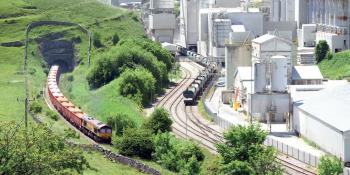MIXED RESULTS FOR IARNRÓD ÉIREANN

The 2017 Iarnród Éireann (IÉ) annual report shows strong growth in passenger numbers, with 45.5 million journeys made, up 6.3% on the previous year and equalling the highest number ever in 2007. The increase is attributed to an improved economy, with more people in employment, the new cross-city service in Dublin (via the Phoenix Park Tunnel, which has seen 700,000 journeys) and higher numbers travelling by rail to special events.
IÉ’s financial position showed improvement last year, with losses reduced from €2.9 million in 2016 to €1.1 million, mainly due to increased farebox revenue and supplementary Government funding; however, the management of funds is still critical. Passenger revenue was the highest ever at €204.9 million, the previous highest being €193.7 million in 2016. The financial position would have been even better had industrial disputes not affected services on several dates during the year – these and changes to zonal pricing in Greater Dublin reduced revenue by €2.4 million. Overall operating revenue was up by €20.3 million at €264.8 million.
Freight revenue (including the ‘Navigator’ logistics business) was down slightly for the first time in several years at €8 million (€9 million in 2016), due to both lower volumes on the bulk ore service and industrial action. Freight traffic represented 100.4 million tonne kilometres (compared to 101.4 million in 2016). Successful trials of longer trains were operated, but these have yet to be introduced on revenue-earning services. More intermodal services between Ballina and Dublin Port were operated for IWT. The DFDS services to Waterford Port ran twice-weekly until February 2018, when they reduced to a single return working per week. The service was withdrawn by DFDS due to it being ‘financially unviable’, with the last working on 5 June; the withdrawal was a surprise as although loadings were light in 2016 it ran mostly fully loaded over the last year. The fact Ireland has the highest track access charges for freight in Europe is considered by most observers to be a key factor.
IÉ’s revenue from rail freight was €4.8 million, with an operating surplus of €1.5 million prior to track access charges of €2.2 million, giving a €0.7 million loss as the net position. Thanks to additional operating charges for freight-only lines the track access charge for freight was higher in 2017 despite the lower tonnage transported and no increase being made to freight rates. Revenue from the IÉ-operated Rosslare Europort remained static at €10.6 million.
Supplementary government funding was provided in the form of grants of €32.8 million in 2017 to specifically fund ballast cleaning, Automatic Train Protection and for the GSMR project, whilst the National Transport Authority provided €32.2 million Public Service Obligation funding for rolling stock maintenance. These short-term funding measures perpetuate the situation IÉ has become used to dealing with in recent years, and the rail funding gap has still to be addressed by the Government, in particular for less well-used rural lines and for acceptance of concessionary and free fares (eg for all pensioners). In December the Labour Court recommendation for the IÉ pay deal was implemented, increasing the payroll by €2.1 million in 2018. Tim Casterton
NEW WATERFORD STATION RECEIVES PLANNING CONSENT
The proposal for the construction of a new transport hub in Waterford, incorporate walking, cycling, bus and rail and featuring a relocated railway station with a 200-space car park, has now received planning permission. The scheme includes the relocation of the current Waterford Plunkett station some 800 metres east along the section of line currently only used by freight movements to and from Bellview Port. The relocation is part of the development of the North Quays area, a scheme long acknowledged as being a necessity for the city and will relocate the station from its present rather isolated location west of Rice Bridge to nearer the city centre. The new site will be linked via a new bridge across the river Suir to ‘the clock tower’.
The new station will have two platforms, each 200 metres long, with this offering greater flexibility, such as for interchange between Dublin and Limerick Junction services. Platforms will be of sufficient length for all regular services and charters using the RPSI ‘Cravens’ carriages, but the ‘Belmond Grand Hibernian’ hotel train, formed of 10 Mk 3 vehicles of a total 230-metre length, will have carriages and the locomotive overhanging the end of the platform (the existing sole operational platform is 234 metres long).
A new ‘greenway’ for pedestrians and cyclists connecting Dungarvan to New Ross along the closed railway formation east of the station will also connect into the new station site. The current station will be demolished, and the railway will continue to be operational through to Bellview Port. Tim Casterton





